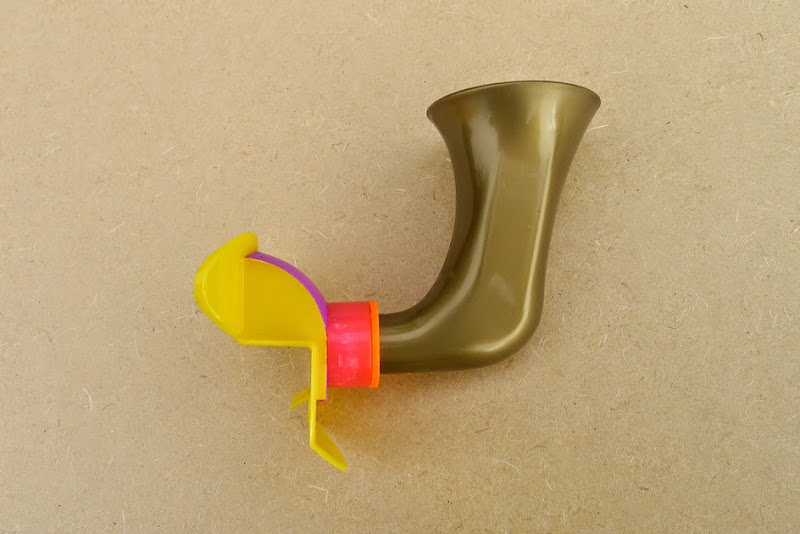The MIM possesses a nose flute, which photo can be seen on Europeana, and accompanied with these comments:
Inventory number 3198
NAZENFLOOT D.R.G.M. Ö.P.O. AUSTOPFON
Germany
A date is provided on the devoted MIM page: before 1913
The picture is medium-small, but large enough to check that the transcription of the stampings is wrong, specifying the noun NAZENFLOOT instead of NASENFLÖTE, which can be read by reversing the picture text (Nazenfloot is *not* a Flemish word for the nose flute).

Redressed image from the picture above:

The stamping D.R.G.M. stands for Deutsches Reichsgebrauchsmuster, meaning that the nose flute was patented either in Germany, or in Austria. It is followed by the acronym Ö.P.O. which could have stood for Österreichisches Patentamt [something] (Austrian Patent Office [smtg]), and thus, would have lead us to an Austrian origin... But the meaning of "Ö.P.O." stays unknown.
Besides that, the brand Austopfon, not fully readable on the picture, was sounding bizarre as to the Nosy Diva (German lady) as to Christian Steinbrecher, musical patents and instruments connoisseur from Austria. Both suggested Austophon, with a "h" instead of the "f", for a more natural Germanic word sounding and morphology. Mr. Steinbrecher even added that if the nose flute was from Austrian origin, it would logically have been from after 1918, since Austria was not existing as such before. In that case, the name would have been built from Austo- (Austria) and -phon ("voice" in ancient Greek).
For sure, I didn't find the patent for this instrument, nor any mention of an Austopfon or Austophon. And since there was at least one mistake in the notice (the funky Nazenfloot), I wrote to the MIM. I received a quick and kind answer from Mr. Wim Bosmans, Curator of the European folk instruments Dept., who ascertained the mistake on Europeana (not Nazenfloot, but Nasenflöte in the stampings), but also confirmed the brand AUSTOPFON, the origin (Germany) and the date ("before 1913"). Mr. Bosmans also added that the instrument was commented in the 5th volume of the Mahillon's catalog, published in 1922, but which listing stopped in 1913, as stated by Mr. Ernest Closson, Mahillon's successor.
I found the 1922 fifth volume of Mahillon's catalog at a reasonable price, and indeed, the article #3198 deals with the Nasenflöte numbered 3198 in the MIM collection. No doubt about which nose flute Mahillon had in hand while writing the notice, but the text doesn't seem to be specific about the Austopfon, as it even doesn't mention the name.


V.-C. Mahillon's french notice says:
Germany. 3198. Nasenflöte (= nasal flute).
Tin device which superior part is set in order to be able to cover the whole nose. The breath projected by the nasal cavities is lead to an ad hoc aperture; it goes along a kind of airway and gets broken against the inferior edge of a rectangular aperture. The superior edge of this latter, folded and bulging, hosts the lip of the player, whilst the portion of the device below this aperture covers the chin. The player's mouth stays open.
Therefore, the air motion shows a certain analogy with the one produced by the bevel fipple flute; the buccal cavity acting as the vessel of the ocarina, the sound acuity results of the air pressure and of the different opening degrees of the cavity: the sound is all the sharper that the mouth is more open. The range of the nose flute spread in average over two octaves and a half, starting from A 58. It is obvious that it is on the player's ear and his skill that depends accuracy, any intermediate note between the two extreme being possible.
So, the instrument is well described, in the shape, usage and acoustic behaviour. We also learn that the Austopfon has a lip rest.
As a first organological classification, it is also interesting to check where Mahillon sorted the nose flute: Appareils Divers ("Miscellanous Devices"), meaning not in the flutes section, but neither with the whistles.

---
The shape of the Austopfon is peculiar: on one hand, it is "very German", because of the rectangular side flaps without rivets, soldered after a small extension of them had been inserted in a little slot and folded on the back. This feature is visible on any of the tin German models (1st version Wunderflöte excepted, which flaps are quarter round):



But on the other hand, the plane part on the top of the airway is longer that the other German models. More, the mouth shield is larger. In fact, on the airway and mouth shield points (but only these), the Austopfon looks very similar to a 1925s Humanatone!

Well, I ordered pictures from the MIM...
---
>>>> Access PART II...




















